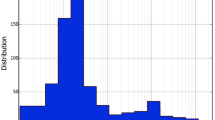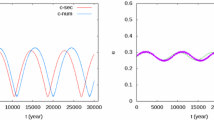Abstract
All results, achieved up to now, show the long term stability of our planetary system, although, especially the inner solar system is chaotic, due to some specific secular resonances. We study, by means of numerical integrations, the dynamical evolution of the planetary system where we concentrate on the stability of motion of the terrestrial planets Venus, Earth and Mars. Our model consists of a simplified planetary system with the inner planets Venus, Earth and Mars as well as Jupiter and Saturn. A mass factor κ was introduced to uniformly change the masses of the terrestrial planets; Jupiter and Saturn were involved in the system with their actual masses. We integrated the equations of motion with a Lie-integration method for a time interval of 107 years. It turned out that when 220 < κ < 245 and κ > 250 the system became unstable due to the strong interactions between the planets. We discuss the model planetary systems for small mass-factors 0.5 ≤ κ ≤ 10 and large ones 160 ≤ κ ≤ 270 with the aid of several different numerical tools. These results can be applied to recently discovered exoplanetary systems, which configuration is comparable to our own.
Similar content being viewed by others
References
Bretagnon, P.: 1974, 'Termes à longues périodes dans le systèmes solaire', Astron. Astrophys. 30, 341-362.
Bretagnon, P.: 1982, 'Theory for the motion of all the planets - the VSOP82 solution', Astron. Astrophys. 114, 278-288.
Chapront, J.: 1995, 'Representation of planetary ephemerides by frequency analysis application to the five outer planets', Astron. Astrophys. 109, 181-192.
Contopoulos, G., Harsoula, M., Voglis, N. and Dvorak, R.: 1999, 'Destruction of islands of stability', J. Phys. A: Math. Gen. 32, 5213-5232.
Dvorak, R.: 1992, 'Unser Planetensystem - ein chaotisches Uhrwerk', Sitzungsberichte der math.-nat. Kl. der Österr. Ak. d. Wiss. Abt.II, Bd. 201, 131-159.
Dvorak, R.: 1998, 'On the dynamics of bodies in our planetary system', Rev. Modern Astron 11, 29-56.
Dvorak, R. and Tsiganis, K.: 2000, 'Why do Trojan ASCs (not) escape?' CMDA 78, 125-136.
Dvorak, R., Müller, P. and Kallrath, J.: 1993, 'A survey of the dynamics of main-belt asteroids. I', Astron. Astrophys. 274, 627-641.
Dvorak, R., Contopoulos, G., Eftthymiopoulos, Ch. and Voglis, N.: 1998, 'Stickiness in map**s and dynamical systems', Planet. Space Sci. 46, 1567-1578.
Hanslmeier, A. and Dvorak, R.: 1984, 'Numerical integration with lie-series', Astron. Astrophys. 132, 203-211.
Holman, M. J. and Wiegert, P. A.: 1999, 'Long-term stability of planets in binary systems', Astron. J. 117, 621-628.
Ito, T. and Tanikawa, K.: 2000, 'Long-term stability of our solar system', In: H. Arakida, Y. Masaki and H. Umehara (eds), Proceedings of the 32nd Symposium on Celestial Mechanics, pp. 47-96.
Jones, B. W., Sleep, P. N. and Chambers, J. E.: 2001, 'The stability of the orbits of terrestrial planets in the habitable zones of known exoplanetary systems', Astron. Astrophys. 366, 254-262.
Kinoshita, H. and Nakai, H.: 1995, 'The motion of Pluto', In: Sylvio Ferraz-Mello, Bruno Morando and Jean-Eudes Arlot (eds), Dynamics, Ephemerides, and Astrometry of the Solar System, IAU Symp. 172, 61-70.
Laskar, J.: 1990, 'The chaotic motion of the solar system. A numerical estimate of the size of the chaotic zones', Icarus 88, 266-291.
Laskar, J.: 1994, 'Large scale chaos in the solar system', Astron. Astrophys. 287, L9-L12.
Laskar, J.: 1996, 'Large scale chaos and marginal stability in the solar system', CMDA 64, 115-162.
Lichtenegger, H.: 1984, 'The dynamics of bodies with variable masses', Celest. Mech. & Dyn. Astr. 34, 357-368.
Morbidelli, A. and Guzzo, M.: 1996, 'The Nekhoroshev theorem and the asteroid belt dynamical system', CMDA 65, 107-136.
Rabl, G. and Dvorak, R.: 1988, 'Satellite-type planetary orbits in double stars: a numerical approach', Astron. Astrophys. 191, 385-391.
Skokos, Ch. and Dokoumetzidis, A.: 2001, 'Effective stability of the Trojan asteroids', Astron. Astrophys. 367, 729-736.
Tsiganis, K., Dvorak, R. and Pilat-Lohinger, E.: 2000, 'Thersites: a 'jum**' Trojan', Astron. Astrophys. 354, 1091-1100.
Wisdom, J.: 1982, 'The origin of the Kirkwood gaps - a map** for asteroidal motion near the 3/1 commensurability', Astron. J. 87, 577-593.
Wisdom, J.: 1992, 'Long term evolution of the solar system', In: Sylvio Ferraz-Mello (ed.), Chaos, Resonance, and Collective Dynamical Phenomena in the Solar System, IAU Symposium 152, 17-25.
Author information
Authors and Affiliations
Rights and permissions
About this article
Cite this article
Dvorak, R., Süli, Á. On the Stability of the Terrestrial Planets as Models for Exosolar Planetary Systems. Celestial Mechanics and Dynamical Astronomy 83, 77–95 (2002). https://doi.org/10.1023/A:1020126612456
Issue Date:
DOI: https://doi.org/10.1023/A:1020126612456




